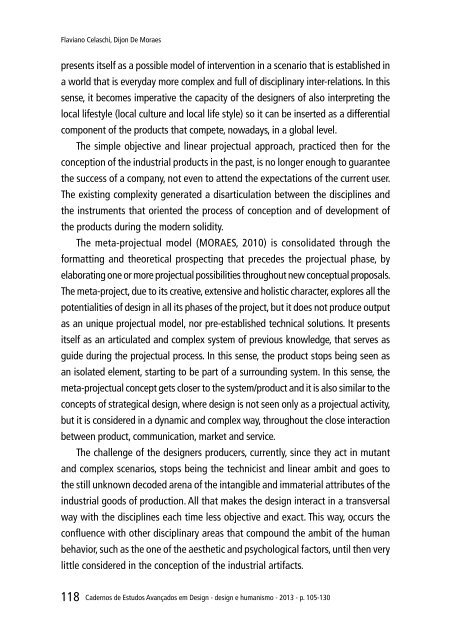o_19po8js951tvs1r0t1r8s4bb1vpla.pdf
You also want an ePaper? Increase the reach of your titles
YUMPU automatically turns print PDFs into web optimized ePapers that Google loves.
Flaviano Celaschi, Dijon De Moraes<br />
presents itself as a possible model of intervention in a scenario that is established in<br />
a world that is everyday more complex and full of disciplinary inter-relations. In this<br />
sense, it becomes imperative the capacity of the designers of also interpreting the<br />
local lifestyle (local culture and local life style) so it can be inserted as a differential<br />
component of the products that compete, nowadays, in a global level.<br />
The simple objective and linear projectual approach, practiced then for the<br />
conception of the industrial products in the past, is no longer enough to guarantee<br />
the success of a company, not even to attend the expectations of the current user.<br />
The existing complexity generated a disarticulation between the disciplines and<br />
the instruments that oriented the process of conception and of development of<br />
the products during the modern solidity.<br />
The meta-projectual model (MORAES, 2010) is consolidated through the<br />
formatting and theoretical prospecting that precedes the projectual phase, by<br />
elaborating one or more projectual possibilities throughout new conceptual proposals.<br />
The meta-project, due to its creative, extensive and holistic character, explores all the<br />
potentialities of design in all its phases of the project, but it does not produce output<br />
as an unique projectual model, nor pre-established technical solutions. It presents<br />
itself as an articulated and complex system of previous knowledge, that serves as<br />
guide during the projectual process. In this sense, the product stops being seen as<br />
an isolated element, starting to be part of a surrounding system. In this sense, the<br />
meta-projectual concept gets closer to the system/product and it is also similar to the<br />
concepts of strategical design, where design is not seen only as a projectual activity,<br />
but it is considered in a dynamic and complex way, throughout the close interaction<br />
between product, communication, market and service.<br />
The challenge of the designers producers, currently, since they act in mutant<br />
and complex scenarios, stops being the technicist and linear ambit and goes to<br />
the still unknown decoded arena of the intangible and immaterial attributes of the<br />
industrial goods of production. All that makes the design interact in a transversal<br />
way with the disciplines each time less objective and exact. This way, occurs the<br />
confluence with other disciplinary areas that compound the ambit of the human<br />
behavior, such as the one of the aesthetic and psychological factors, until then very<br />
little considered in the conception of the industrial artifacts.<br />
118<br />
Cadernos de Estudos Avançados em Design - design e humanismo - 2013 - p. 105-130



